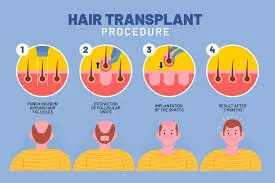FUE vs FUT | Hair Transplant Shifting Towards Modern Technique: Assure Clinic
FUE vs. FUT: Discover why modern hair transplant techniques like FUE are gaining popularity over traditional FUT, offering less pain, scarring, and faster recovery.
image for illustrative purpose

Hair restoration has evolved rapidly over the past two decades, offering individuals struggling with hair loss more refined, effective, and minimally invasive solutions. Among the most widely discussed choices are two surgical methods: FUE (Follicular Unit Extraction) and FUT (Follicular Unit Transplantation).
While both techniques have played pivotal roles in the advancement of hair restoration, the ongoing trend across clinics and among patients alike points to one conclusion: FUE is the present and future of hair transplantation, while FUT is quickly becoming an outdated option.
Understanding the Techniques: FUE vs. FUT
To understand the shift, it’s essential to distinguish between the two procedures.
What is FUE hair transplant?
FUE involves extracting individual follicular units from the scalp using a fine punch device, often less than 1mm in diameter. These grafts are then implanted directly into the areas experiencing hair loss. The process leaves behind micro-dots instead of a visible linear scar, enabling a more discreet recovery and the option to wear shorter hairstyles.
By contrast, what is FUT hair transplant?
FUT requires the surgical removal of a strip of scalp tissue from the donor area. The strip is dissected into grafts, which are then implanted into the recipient area. Though efficient in yielding a large number of grafts, FUT leaves a linear scar and often involves a longer and more uncomfortable recovery period.
Why FUE Is Now the Preferred Technique
The FUE technique hair transplant has become increasingly preferred for several reasons:
● Minimal scarring: The dot-like marks are virtually undetectable, especially when performed with precision.
● Faster recovery: Most patients resume normal activities within a week.
● Natural aesthetics: Individual placement of follicles allows for better angling, density, and blending.
● Flexibility in hairstyle: Short or cropped haircuts remain a viable option without worrying about concealing a scar.
Although FUE hair transplant cost may be higher on a per-graft basis than FUT, patients often consider it a worthwhile investment for the long-term cosmetic and practical benefits.
Why FUT Is Losing Relevance
While FUT hair transplant once held ground as a preferred technique due to its graft yield, it's increasingly viewed as invasive and outdated. The need for stitches, longer healing time, and the unavoidable scar have made it less appealing—particularly as FUE techniques have advanced.
Clinics prioritizing modernity and patient comfort are gradually phasing out FUT in favor of minimally invasive solutions. As one leading dermatologist noted, “Medical aesthetics is as much about how the patient heals and lives post-procedure as it is about the outcome.”
Clinical Trends and Expert Insights
Clinics with a global reputation for innovation, such as Assure Clinic, have contributed to the adoption of modern FUE by investing in technologies that maximize graft survival and patient safety. According to their dermatological team, the clinic performs only doctor-led procedures using ultra-fine extraction tools, designed to reduce trauma to both the donor and recipient areas.
A segmented session approach, which divides the procedure across multiple shorter sittings, is also gaining traction. This not only improves graft survival rates but enhances the surgeon’s precision while reducing overall downtime for the patient.
FUE vs. FUT: A Quick Comparison
Feature FUE Hair Transplant FUT Hair Transplant
Technique Individual follicle extraction Strip of scalp removed
Scarring Dot-like, barely visible Linear scar
Recovery Time 5–7 days 10–14 days
Aesthetic Outcome Natural, customizable Risk of patchy appearance
Cost per Graft Slightly higher Lower
Suitability Ideal for short hairstyles Better for extensive baldness cases
The Future of Hair Restoration
As patient awareness grows and medical technology advances, the preference for less invasive and more refined treatments like FUE becomes clearer. While fue vs fut debates still surface online, the growing consensus in dermatological circles is that FUE represents the most effective and patient-friendly approach available today.
Clinics across India and internationally, particularly those at the forefront of innovation, continue to refine FUE techniques, combining medical precision with aesthetic artistry. The result? A future of hair restoration where natural outcomes, minimal recovery, and donor preservation take priority.

